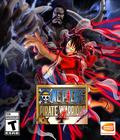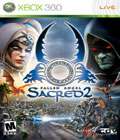While Blizzard's World of Warcraft may be the current champ of time-draining addictive PC games, it was far from their first. Long before World of Warcraft was even a glimmer in a Blizzard programmer's eye, they had the Diablo franchise, a pair of ridiculously addictive hack-and-slash action-RPGs that drained countless hours from gamers. Unsurprisingly, these games spawned a staggering number of clones, both good and bad, but the gameplay didn't translate well to console titles. A few attempts were made to port Diablo and some of its ilk to systems like the PlayStation, but the console ports always felt inferior to the PC original; even Diablo clones made specifically for consoles had a hard time capturing the same fun feeling. This is why it's surprising that, for all of its flaws, Sacred 2: Fallen Angel manages to be a PC port that does a solid, if imperfect, job of porting a formerly PC-exclusive Diablo clone to a console.
Sacred 2 is sent in the fantasy land of Ancaria. A group of High Elves has gained access to a deus ex machina power source called T-Energy, which has made them an unstoppable force. This has upset the balance of the land, and the High Elves are dealing with a mini civil war over who gets to rule the populace. Meanwhile, various forces, both good and evil, swoop in to claim the T-Energy for their own. As if that weren't difficult enough, T-Energy is very unstable and can destroy entire cities and mutate beings into terrible monsters. The plot is paper-thin and is mostly there as an excuse to justify why you're going around and punching things in the face, but even the most curious gamer will probably forget about it halfway through the game, aside from perhaps recognizing a few familiar names when a boss fight is imminent.
Players are given a choice of six playable classes: Dryad, High Elf, Inquisitor, The Seraphim, Shadow Warrior or Temple Guardian. Most of these classes can choose between Light and Darkness, but the Seraphim, as the embodiment of purity and light, is pretty much stuck on the Light path. Weirdly, there isn't really much you can do to personalize a character beyond selecting a class and name. Each class has a fixed gender, so you can't play a male Dryad or a female Temple Guardian, and you can't change the characters in any noticeable way. The female characters have two hairstyles, and you can alter their hair color, but that is about all you can do to differentiate your character from a friend's. It's a minor complaint really, but considering how simplistic the character models are, it would've been nice to have slightly more variety in their appearance, instead of being stuck with a Seraphim with blonde pigtails or a Seraphim with blue pigtails.
The hardest part of making a console Diablo clone is making sure the player doesn't feel limited by his skill selection. Even modern game controllers have only a handful of buttons and can't come close to offering as many possible button combinations as a PC game. Sacred 2 does a pretty admirable job of giving players access to most of their abilities without overly limiting them, and while the control scheme is sometimes a little awkward, it works fairly well. Players have access to 12 skill slots, divided evenly among 3 sets. To activate any of the skills in the first set, you press a corresponding face button on the Xbox 360 controller. Holding one of the trigger buttons will switch you over to the second or third set, and you can then activate the skills in the same fashion. Items are bound to the d-pad and it works rather well, but the sticky and imprecise d-pad can sometimes register wrong direction pushes during frantic combat. The bumpers control interaction with the environment. Perhaps the only thing really holding back the game is that the menus are awkward to browse with a controller instead of a mouse, and while it doesn't ruin the game, it's the most noticeable shortcoming of the console port.
At its heart, Sacred 2 is a pretty traditional Diablo clone. Other than providing a setting for the world, the plot isn't going to factor into your gameplay too much. Whether you're good or evil, your basic goal is the same: run from quest giver to quest giver, perform the quest, and reap the lovely and shiny rewards. There isn't anything particularly complex here, and most of your quests are going to be the usual "kill X number of Y enemy" or "find this item" variety. As is the norm for the genre, quests simply give you an excuse to kill anything in your path in the pursuit of goodies, and Sacred 2 does a good job of ensuring that you're kept busy. There are plenty of quests for even the most eager gamer. There isn't a great assortment of missions, but you'll be surprised at how addictive it is to keep getting new quests and racking up more prizes.
Of course, the primary reason to do missions is to power up your characters. Weapons and armor are self-explanatory: You collect and equip them to increase your character's attack and defensive abilities. You can also activate up to six relics, which can be used to further boost your armor's protection, although you can only equip up to three at a time. Likewise, fighting and gaining levels to improve your stats is something that almost every gamer should be familiar with.
The most important thing to focus on is character skills. Unlike similar games, you don't gain new skills by merely leveling up; you must find special runes to upgrade your skills. Your abilities are determined by your selected class and the deity that you chose for that class. My favorite was the Temple Guardian, a bizarre biomechanical Anubis creature who rode around on gigantic robotic wheel and used a transforming robotic arm to fight. Weird as this may sound, he worked very well in conjunction with other players and was a solid support class. Whichever class you choose, there is a wide variety of potential combat options. To unlock these new options, though, you have to perform quests, and so the vicious circle continues.
Sacred 2 can be played single-player, but it's really a game designed to be played with friends. Even when you're playing a single-player campaign, it feels like you're playing a multiplayer campaign without a friend tagging along. Fortunately, the title offers a good variety of customization options for online gaming. You can set the number of players (up to four at a time), level range, difficulty and even PvP settings. One particularly interesting mode is Free World, which allows you to play the game without any story. Side-quests will still be available, but it really boils down the game to its bare essentials. If you're not planning to play Sacred 2 with other people, it loses a lot of its fun, and while there is certainly something there for single players, it's far from ideal.
Graphically, there isn't much to say about Sacred 2. The world is rather nice-looking, and a lot of the environments have a surprising amount of detail. The character models are bland and seem out of place among the nice environments, with rather poor texturing and bland and awkward animations. Even the attack and spell effects are lackluster, and the game feels uninteresting to watch. Considering the extremely limited character creation options, more effort could have been put into making those choices more visually interesting. There were also a number of frame rate and screen-tearing issues. Installing the game to the hard drive helped a bit, but there were still minor problems here and there.
If there is one drastically memorable thing about Sacred 2, it's the game's voice acting, which is atrocious. It goes beyond the point of being simply bad and falls to the delightfully goofy level of "Mystery Science Theater 3000"; it's so bad that you can't help but laugh. The first time I played the game, I thought I was in for some sort of lampooning parody but was surprised to find that the game took itself seriously. The end result is that the already paper-thin story is made slightly ridiculous by the hilariously overdramatic voicework. It's not necessarily a bad thing, as it provides a fair bit of amusement, but it certainly can't be good in any fashion. At best, it brings up memories of games like Resident Evil or Symphony of the Night. Fortunately, the game's background music is very good and even includes a song by Blind Guardian, which should provide of some interest to fans of German power metal. Sadly, nothing in the game's soundtrack is memorable enough to draw attention away from the hilarious voice acting, but at least it doesn't hurt the experience either.
Sacred 2: Fallen Angel was an average Diablo clone on the PC, but it stands out on consoles, mostly due to the lack of any serious competition. The gameplay is solid and fun, if not particularly innovative. The adaptation of PC controls for a console game went as smooth as can be expected, and while it isn't perfect, it's solid enough that the flaws can be overlooked. Perhaps the game's only real issues come from the presentation, with mediocre visuals and atrocious voice acting. If you can overlook that, you'll find an overall solid Diablo clone that should keep players busy for quite a while.
Score: 7.0/10
More articles about Sacred 2: Fallen Angel











 Sacred 2: Fallen Angel is an action RPG with a rich story that takes place in a giant, open-ended and seamless world. This world contains hundreds of dungeons, treacherous opponents and a variety of challenging quests. Intelligent enemies challenge in heroic single- and multiplayer battles.
Sacred 2: Fallen Angel is an action RPG with a rich story that takes place in a giant, open-ended and seamless world. This world contains hundreds of dungeons, treacherous opponents and a variety of challenging quests. Intelligent enemies challenge in heroic single- and multiplayer battles.











































